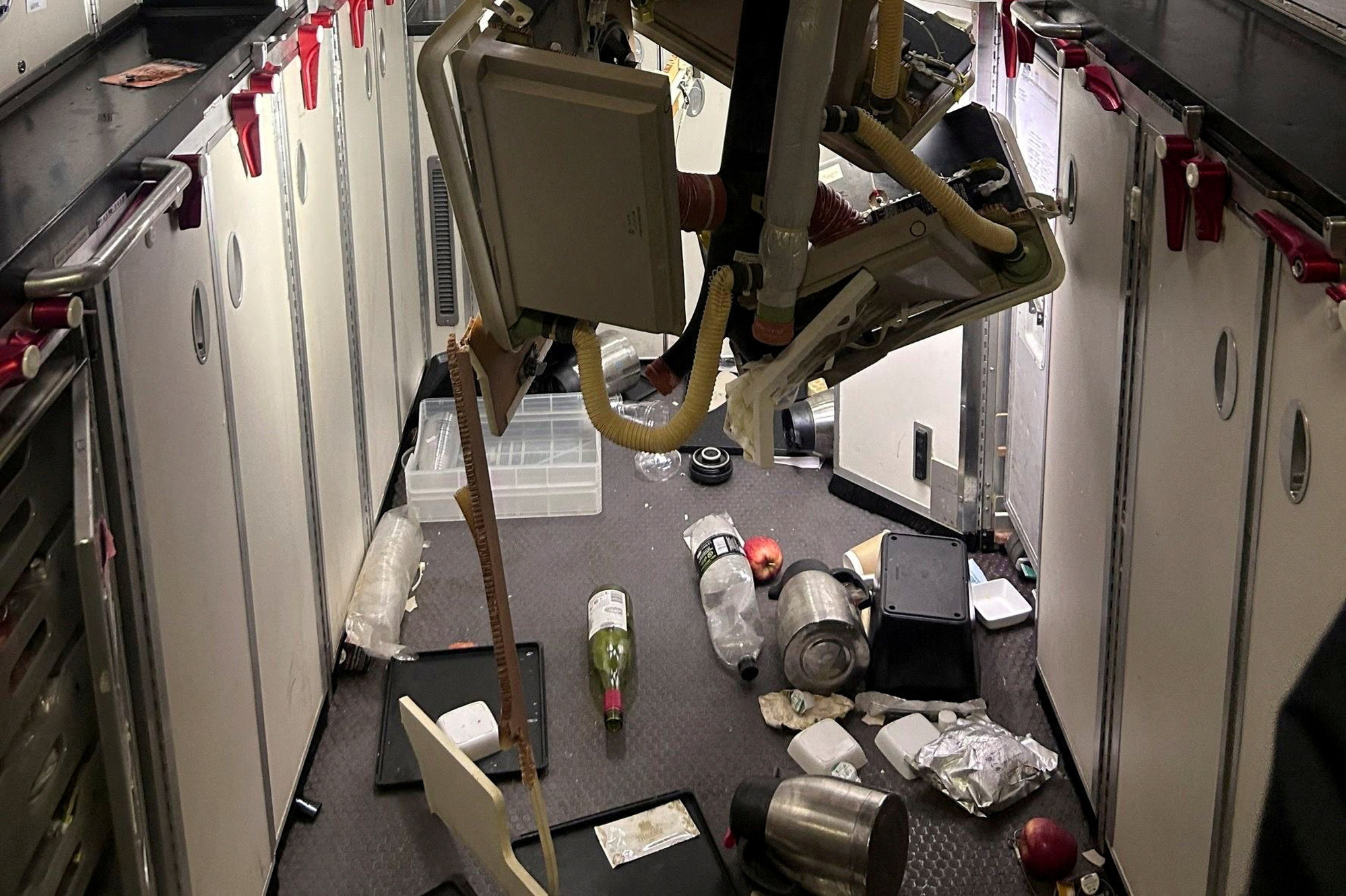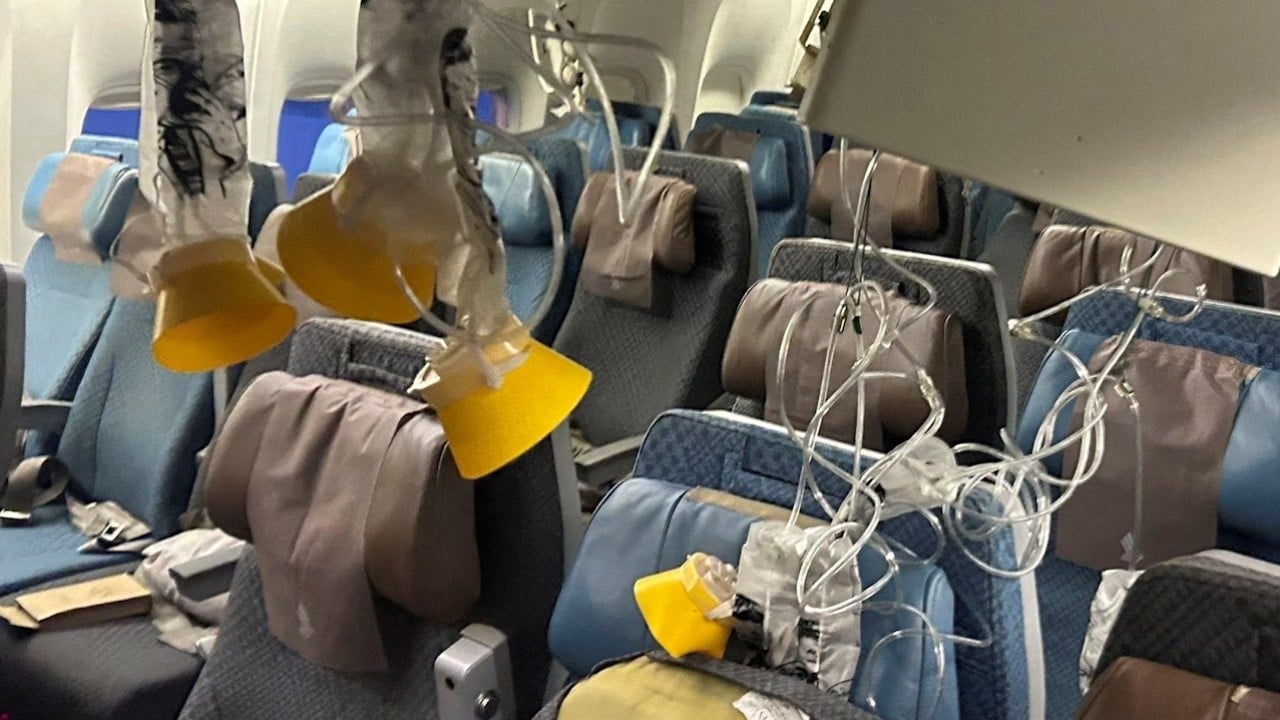
Singapore Airlines SQ321 turbulence: rapid G-force changes over 4.6 seconds likely caused injuries, investigators say
- The preliminary findings by a team of investigators looking into the incident showed the flight was normal before the turbulence event
- A former Singapore Airlines pilot compares rapid gravitational force changes to ‘a roller-coaster going from the peak to the bottom of the ride’
Aviation experts told This Week In Asia that the preliminary findings did not reveal anything surprising and were par for the course in such aviation investigations.
Following the incident, Singapore Airlines announced last week that it would suspend meal services and have crew members return to their seats and put on their seat belts during an activation of the seat belt sign, in a move to take on “a more cautious approach to managing turbulence in-flight”.
The crew would also continue to advise passengers to return to their seats and secure their seat belts, and monitor customers who may require help, including those in the lavatories, a Singapore Airlines spokeswoman said.

Hong Kong’s Greater Bay Airlines also announced on Wednesday that it would encourage passengers to fasten their seat belts at all times, with reminders from cabin crew and announcements on board.
Singapore’s transport ministry on Wednesday said the Transport Safety Investigation Bureau of Singapore had extracted the data stored in the flight data recorder and cockpit voice recorder of flight SQ321.
A team of investigators – from Singapore’s bureau and United States representatives from the National Transportation Safety Board, the Federal Aviation Administration and planemaker Boeing – have compiled a chronology of events based on their preliminary analysis.
They found that the flight was normal before the turbulence event. But when the plane passed over the south of Myanmar, it likely flew over an area of “developing convective activity” at 37,000 feet. Convective activity or convection in this instance refers to the process by which heat travels through air.
At 07.49am Coordinate Universal Time or UTC (11.49pm Hong Kong time, May 20) the gravitational force fluctuated between positive 0.44G and positive 1.57G for about 19 seconds.
This would have caused the flight to begin experiencing slight vibration, said the ministry.

“Around the same time as the onset of the slight vibration, an uncommanded increase in aircraft altitude, reaching a peak of 37,362ft, was recorded. In response to this uncommanded altitude increase, the autopilot pitched the aircraft downwards to descend back to the selected altitude of 37,000ft,” it added.
Convective activity was expected in the region during that time of the day, said Albert Tiong, a chief ground instructor at Seletar Flight Academy. “When the weather is hot, air becomes thinner as air density becomes lower – just like a hot-air balloon. The thinner air starts to rise, and the hotter the ground, the faster the air rises,” Tiong said.
He speculated that the aircraft may have flown above thunderstorm clouds, which may have caused the airborne weather radar, which was used to alert pilots to the intensity of convective weather, to have missed out on signalling convective activity.
The ministry said that the pilots also observed an uncommanded increase in airspeed, which they limited by extending the speed brakes.
While managing the airspeed, a pilot was heard calling out that the fasten seat belt sign had been switched on.
The ministry said that this uncommanded increase in aircraft altitude and airspeed was most likely due to an upward air movement against the aircraft.
Eight seconds later, the aircraft experienced a “rapid change in gravitational force”, with the recorded vertical acceleration decreasing from positive 1.35G to negative 1.5G within 0.6 seconds.
“This likely resulted in the occupants who were not belted up to become airborne,” said the ministry.
One second later, the vertical acceleration changed from negative 1.5G to positive 1.5G within four seconds, which resulted in the occupants who were airborne to fall back down.
“The rapid changes in G over the 4.6-second duration resulted in an altitude drop of 178ft, from 37,362ft to 37,184ft. This sequence of events likely caused the injuries to the crew and passengers,” said the ministry.
A former Singapore Airlines pilot with more than 30 years of flying experience compared the rapid changes in the G-force within a short duration to “a roller-coaster going from the peak to the bottom of the ride”.
On the altitude drop of 178ft in 4.6 seconds, the former pilot who declined to be named said: “It’s about 2,000ft per minute which is quite normal, but it’s the sudden up and down [movement] in a short duration that causes the damage.”
During the rapid changes in gravitational force, recorded data showed that the pilots initiated control inputs to stabilise the aircraft and switched off the autopilot.
They manually controlled the aircraft for 21 seconds and switched on the autopilot at 7.50am UTC.

Over the next 24 seconds, more gradual fluctuations in vertical acceleration were recorded, ranging from positive 0.9G to positive 1.1G, while the aircraft returned to 37,000ft.
The activation of the autopilot system was to allow pilots to “focus on higher-level tasks while the system handles routine flight control duties”, said Tiong. There have been instances in past flights involving other airlines where an aircraft autopilot system had “behaved erratically”, he added, citing a Malaysia Airlines flight from Australia in 2005, when the plane’s software incorrectly measured speed and acceleration, causing it to suddenly ascend 900 metres.
“But there is currently no evidence of that happening with SQ321,” he said.
The Singapore Airlines pilots made the decision to divert the plane to Suvarnabhumi Airport, Bangkok, after the cabin crew told them there were injured passengers. They requested medical services to meet the aircraft on arrival.
About 17 minutes after the turbulence event, at 8.06am UTC, the pilots initiated a normal, controlled descent from 37,000ft and the aircraft reached 31,000ft at 8.10am UTC. The data showed that the aircraft did not encounter further severe turbulence during this diversion, and touched down in Suvarnabhumi Airport at 8.45am UTC.
The authorities are still investigating the incident.

Michael Daniel, managing director of Aviation Insight, an aviation consultancy, said the rest of the investigations into the incident would look at what information the pilots had and when they received it.
“I don’t see anything that catches me by surprise. This is what I had estimated during the course of investigations. They’re on track to determining probable cause before going on to the next step, which is making recommendations,” he said.
Singapore Airlines on Wednesday acknowledged the preliminary investigation findings and said it was cooperating with the relevant authorities in the investigations.
“We are committed to supporting our passengers and crew members who were on board SQ321 on that day, as well as their families and loved ones. This includes covering their medical and hospital expenses, as well as any additional assistance they may need,” said the airline.
On Wednesday night the airline said that 42 passengers on board SQ321 were still in Bangkok. This includes 26 passengers receiving medical treatment in hospital.



